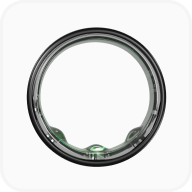
Resting heart rate and VO2 max: Key health markers you need to know
In the realm of fitness and overall health, two critical markers stand out: average resting heart rate (RHR) and VO2 max. Understanding these metrics and their implications can provide valuable insights into your cardiovascular health and fitness levels.
This blog delves into what RHR and VO2 max are, their significance, and how they interrelate, along with practical ways to measure and improve them.
Understanding resting heart rate (RHR)
Average resting heart rate (RHR) measures the number of heartbeats per minute while at rest. It reflects heart efficiency, with lower RHR indicating better cardiovascular fitness. Several factors, including fitness level and health status, can influence RHR.

- Average range: 60-100 beats per minute (bpm) for adults
- Athlete RHR: Often below 60 bpm
- Influencing factors: Age, fitness level, medication, emotional state
How to measure RHR
- Find a quiet place to lie down or sit and relax.
- Locate your pulse on your wrist or neck with the help of your index and middle fingers.
- Count the beats for 30 seconds and multiply it by two.
Tools for accurate measurement
- Manual measurement: Counting pulse beat
- Smart devices: Gabit Smart Ring for continuous monitoring and accurate data insights

Understanding VO2 max and its importance
VO2 max is the maximum rate of oxygen consumption measured during intense exercise. It is a key indicator of cardiovascular fitness and aerobic endurance, reflecting how well the body uses oxygen.

- VO2 max meaning: Maximal oxygen uptake during exercise
- Indicators: Cardiovascular fitness and aerobic capacity
- Benefits of high VO2 max: Better endurance, reduced chronic disease risk, improved overall health
Influencing factors
- Genetics: Inherent capacity for oxygen consumption
- Age: VO2 max decreases with age
- Sex: Generally higher in males than females
- Training: Regular endurance training can significantly improve VO2 max

Why VO2 max is important
- Performance: Higher VO2 max enhances athletic performance
- Health: Better heart health and lower risk of chronic diseases
- Longevity: Associated with increased lifespan
How to improve VO2 max
- Exercise types: Running, cycling, swimming, high-intensity interval training (HIIT)
- Consistency: Regular and varied aerobic workouts
- Tracking: Use devices like the Gabit Smart Ring for progress monitoring

The relationship between resting heart rate and VO2 max
RHR and VO2 max are interrelated, providing insights into cardiovascular fitness. Typically, individuals with higher VO2 max tend to have lower RHR, indicating efficient heart function.
How they relate
- Higher VO2 max: Generally correlates with lower RHR
- Heart efficiency: Enhanced by regular aerobic exercise
- Feedback loop: Improvements in one can positively affect the other
Improving VO2 max to lower RHR
- Stronger heart: Aerobic exercise strengthens the heart, lowering RHR
- Efficient pumping: Heart pumps more blood per beat, reducing the need for a high rate at rest
Monitoring progress
- RHR tracking: Provides feedback on cardiovascular fitness levels
- VO2 max training: Regular monitoring helps assess training effectiveness

Conclusion
Understanding and monitoring your average resting heart rate and VO2 max are crucial for maintaining optimal cardiovascular health and fitness. These metrics not only provide insights into your current fitness level but also guide you in making informed decisions about your exercise and lifestyle choices.

Using tools like the Gabit Smart Ring can help you track these vital statistics accurately, enabling you to take proactive steps towards a healthier, more active life.
Frequently Asked Questions
What is a good resting heart rate for adults?
A good average resting heart rate for adults typically ranges from 60 to 100 beats per minute. However, a lower RHR is often seen in physically fit individuals, sometimes dropping below 60 bpm. A consistently low RHR usually indicates a well-conditioned heart, while a higher RHR could be a sign to check in with your healthcare provider.
How can I accurately measure my resting heart rate?
To measure your RHR accurately, sit or lie down in a quiet environment and relax. Place your index and middle fingers on your wrist or neck to locate your pulse. Count the number of beats in 60 seconds. For more precise and continuous monitoring, the Gabit Smart Ring is an excellent choice. It tracks your heart rate throughout the day and night, providing comprehensive insights into your cardiovascular health.

What is VO2 max, and why is it important?
VO2 max is the maximum rate at which your body can consume oxygen in the middle of intense exercise. It is a key indicator of aerobic fitness and cardiovascular health. A higher VO2 max means better endurance and athletic performance, as well as a lower risk of chronic diseases and improved overall health.
How can I improve my VO2 max?
Improving your VO2 max involves regular aerobic exercise. Activities such as running, cycling, swimming, and HIIT are particularly effective. Consistency is key, and incorporating a variety of workouts can help maximise improvements. Tracking your progress with a device like the Gabit Smart Ring can provide motivation and ensure you are on the right track.
Can improving my VO2 max lower my resting heart rate?
Yes, improving your VO2 max through consistent aerobic exercise can lead to a lower resting heart rate. As your cardiovascular system becomes more efficient, your heart can pump more blood per beat, reducing the need for a higher heart rate at rest. This relationship underscores the importance of maintaining a regular exercise routine for overall heart health.









